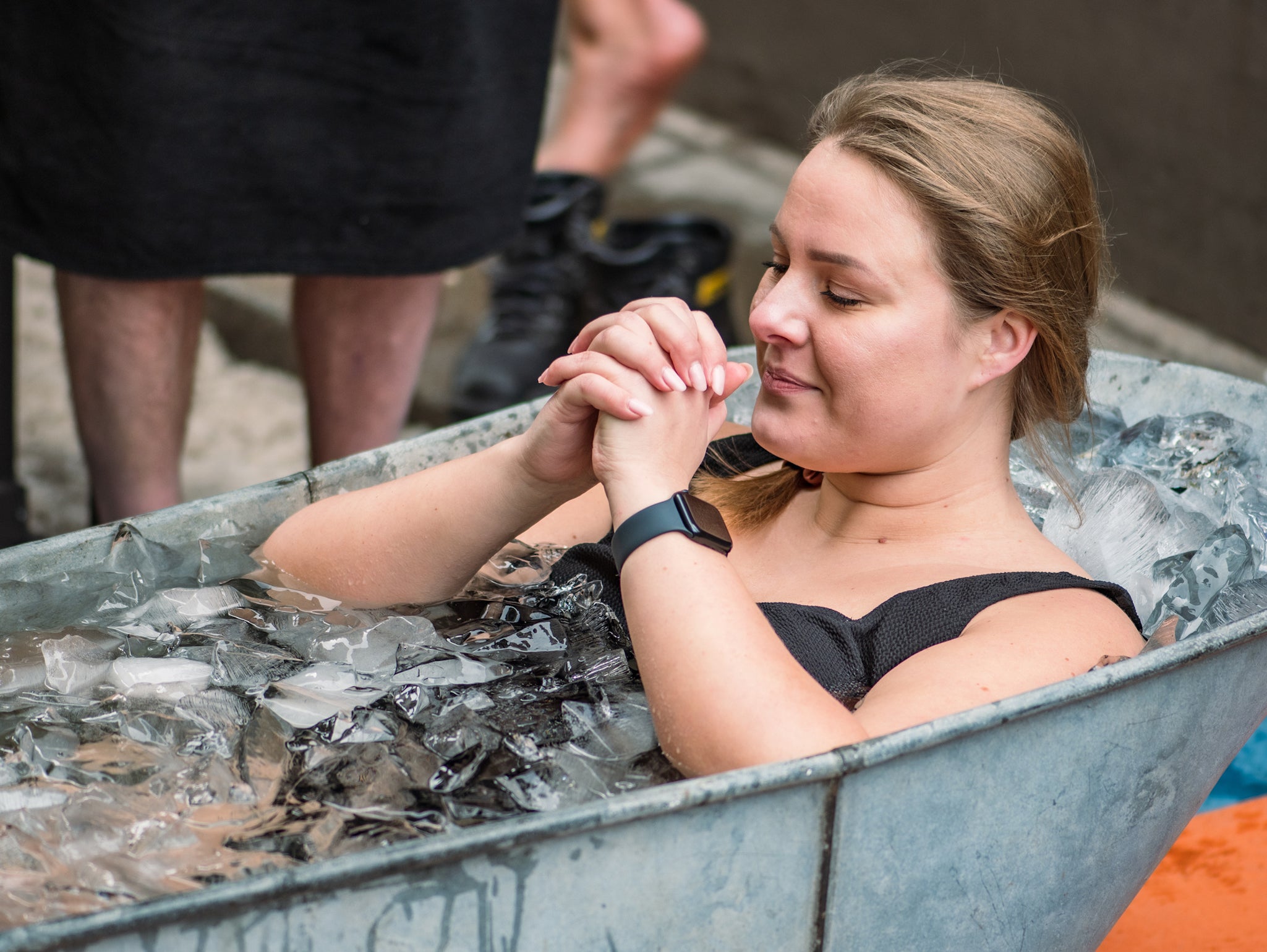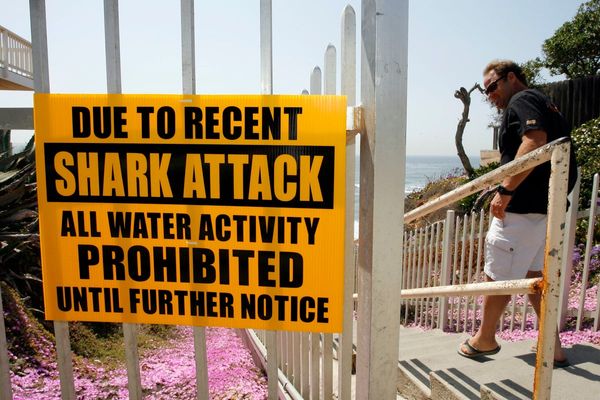
Whether you start your day by dunking your face in a bowl of ice water like a fitness influencer with too much time on your hands or go for a full-body immersion in an ice bath, if you’ve fallen for the lure of cold therapy this year, you’re not alone. Cold water swimming, cold plunges, and cryotherapy are all part of the longevity boom, a preventative health movement that aims to extend our life spans and slow the ageing process.
The biohacking crowd has been extolling the virtues of cold exposure for many years, claiming it can both soothe the nervous system and give you more energy. Ice bath evangelists will tell you a cold dip is also great for metabolic function and mitochondrial efficiency.
It seems the whole health and wellbeing landscape is shifting in favour of the cold, and new health clubs are opening all over the UK, each offering different ways to engage with the cold for improved wellbeing. Last week, I spent three and a half minutes in a cryochamber, and while it wasn’t exactly relaxing, I felt incredible afterwards.
There are plenty of studies that show how beneficial cold exposure can be, but there are also obvious risks and drawbacks associated with it. There have been deaths and medical emergencies associated with ice baths and cold water swimming, and those with heart conditions are strongly advised to avoid cold water submersion below 27C.
Personally, I’ve attempted to swerve the ice bath trend in the past. There’s something about submersion, particularly in cold water, that makes me feel anxious, and that feeling tends to permeate my state of mind long after I’m out of the water. I don’t experience the soothing properties everyone speaks of, I just feel jangly. It’s never been a biohacking pursuit that I’ve benefitted from. I believe there are also some elements of biohacking that are probably a little unnecessary. Unless you’re in recovery and it’s been prescribed, for example, you don’t need to climb into an oxygen chamber.
There’s also a gender research gap when it comes to many biohacking practices, cold exposure included. Much of the scientific evidence on both cold and heat exposure is based on male biology, which means our knowledge of the benefits and side effects for women is somewhat limited.
“While many biohacking principles apply to both men and women, hormonal fluctuations, toxin storage, and metabolic differences necessitate unique protocols for women,” says biohacking expert Kayla Barnes-Lentz. Barnes-Lentz has amassed a loyal following on social media and shares her routines and protocols with an audience of women seeking science-backed health advice.
“Although ice baths can have incredible benefits from nervous system to inflammation to muscle soreness and vagus nerve support, it's time to understand female biology and avoid the fight or flight response and fertility challenges that ice cold water can trigger,” she says.
Barnes-Lentz’s comments suggest cold exposure might not be the panacea that health influencers suggest it is. According to some experts, for women, there’s actually a whole deck of factors to consider before jumping in a tub full of ice, from the stage of your menstrual cycle to whether you’ve eaten that day.
Are ice baths good for women?
Cold exposure elicits a number of physiological responses in the body. Regular and short exposures to cold water immersion (where you are aiming to micro-stress the body) provide powerful stimulus and the body reacts as if in danger,” explains women’s health and contrast therapy expert Jane Witt.
“Firstly, the cold receptors in the skin are activated and activate the nervous system immediately with a direct pathway to the brown fat (often referred to as brown adipose tissue) which is the body's emergency organ to keep it warm.”
At the same time, “submersion in water activates the diving response and vagus nerve which activates the body's sympathetic (fight or flight) nervous system to increase blood pressure and heart rate. Concurrently, this activates the parasympathetic nervous system, which makes the heart rate go down. This creates a conflict for the systems known as ‘autonomous conflict’, which lasts for less than a minute.”
Witt explains that these responses, which can feel overwhelming, can be controlled with your breath. It’s our natural reflex to gasp and hyperventilate when we’re cold, but when doing cold therapy, you’ll be encouraged to overcome that instinct and breathe slowly. If you don’t control your breathing, it’s much harder to withstand the cold and stay calm.
Read more: Best women’s gym trainers, according to a fitness editor
Danyl Bosomworth, founder of ice bath company Brass Monkey, explains that despite breathing exercises lessening the anxiety-inducing impacts of a cold plunge, there are still several aspects of women’s physiology that can make the experience of a cold plunge into icy water a different one to that of men.
“Women's bodies may prioritise blood flow to core organs, which can make extremities feel colder. They might also begin shivering earlier in response to cold as a heat-generating mechanism,” he says. “Women, on average, have a higher body fat percentage, providing insulation but less heat generation. Women also tend to have a smaller body surface area to volume ratio, potentially leading to quicker heat loss. Additionally, women generally have a lower metabolic rate than men, meaning less heat production at rest.
“Of course, individual responses to cold can vary significantly based on factors like clothing, activity level and even mental state. Ultimately, just like with any therapy, everyone is different. Age, fitness, body composition, health conditions – they all play a part. But for women, this individual variability is even more important to pay attention to.”

Are ice baths good or bad for hormones?
One of the most important variables here is hormones. The body’s natural response when submerged in cold water is to increase noradrenaline, adrenaline and cortisol. “These hormones are designed to give the body energy to escape stressful situations, where they activate the sympathetic nervous system (fight and flight),” explains Witt.
“Happiness hormones also increase during cold water immersion and beyond; for example dopamine increases by two and a half times up to four hours after cold exposure. Dopamine elicits feelings of satisfaction, motivation and drive. Serotonin is also released by cold immersion, which gives a sense of mental balance and inner peace.”
The final hormone released during cold immersion is oxytocin, which is known as the love and socialising hormone. Brown fat has oxytocin receptors that are activated during cold water immersion. The warm feeling of love that is often experienced after cold water immersion comes from brown fat and oxytocin.”
Read more: Best mindfulness apps for soothing anxiety
A hormonal shift can affect other hormones in the body, and Barnes-Lentz explains that though ice baths can have incredible benefits, their impact on female hormones is distinct.
Progesterone and cortisol can work in competition with one another. “Excessive cold exposure during the luteal phase [of your cycle] can increase cortisol, depleting progesterone. This is what’s known as ‘progesterone steal’,” she explains. Often, people who experience very high levels of stress and anxiety suffer from progesterone steal due to high levels of cortisol, and this can lead to irregular or absent periods.
When your hormones are in a state of imbalance, this can lead to several health issues linked to sleep, fertility and mood so it’s important not to put too much consistent stress on the body, either via a cold plunge or in other ways.
“Cold therapy enhances circulation, which may support ovarian function and some studies suggest improved blood flow helps follicular health. But utilising it at the right time is key,” says Barnes-Lentz. “l'd keep ice baths for the follicular phase while avoiding them in ovulation.”
Read more: The best spa hotels in the UK
The podcaster uses a cold plunge herself but stresses the importance of doing so at the right time for better hormonal support. She also recommends a slightly higher temperature of around 12C instead of freezing.
“Our nervous systems are consistently ‘under load’, and where ice baths are easier some days than others (for everybody), it becomes essential for women to be mindful of how they approach ice baths, not if they should,” agrees Bosomworth. “Add to the complexities of perimenopause and monthly cycles, the strain on the nervous system can be significantly amplified.”
Of course, you can train your body to withstand the cold, and longer or more frequent ice bath sessions might benefit you, depending on your tolerance and your ability to adapt. Pain tolerance and reaction to the cold can be dependent on which stage of your cycle you’re in – during menstruation, we tend to feel pain more acutely, but less so in other phases. So, if you’re keen to experience the benefits of cold therapy and build up your tolerance, doing so at certain times of the month might help.
Witt explains that “cold shock lasts up to a minute before the parasympathetic nervous system (the rest and digest system) kicks in. The body will always react, but it will adapt. After as few as three cold immersions, this will already start to help the body adapt to stressful situations. Cold adaptation is achieved by regular cold exposure, and this is where the major benefits of cold water immersion occur.”
Cold for recovery
The benefits of cold water are well documented – relief from joint and muscle pain, improved mood and mental resilience, improved circulation and sounder sleep. The idea is that cold exposure decreases inflammation in the body and inflammation is the main offender when it comes to most of our aches and pains.
“Women's hormonal fluctuations, especially estrogen, influence recovery and inflammation differently throughout their cycles. This means that for women, the timing and intensity might need a more personalised approach to really maximise the benefits,” explains Bosomworth.
“Women naturally vasodilate more after exercise, and cold plunges help redistribute blood centrally without excessively constricting vessels, allowing for faster recovery without compromising strength gains. Men, by contrast, experience strong vasoconstriction post-exercise, and immediate cold exposure can blunt hypertrophy signals.”
On this basis, cold immersion could actually be a more effective recovery tool for women after exercise compared to men. Its impacts on joint pain, mood and improved mobility explain why so many women in menopause turn to cold water swimming to ease symptoms and why so many women are seeking out health clubs and gyms that offer a cold plunge or ice bath experience.
“The natural release of oxytocin is why we often see large groups and communities forming around cold water or winter swimming,” adds Witt. “The release of all these hormones during the cold shock response saves the body from hypothermia but also has incredibly positive impacts on mental wellbeing as a consequence. The release of endorphins – which are the body’s natural painkiller – gives the instant feeling of joy and pain relief in the body after cold exposure.”
“Hormonal balance, stress reduction and the potential metabolic boost are all incredibly valuable,” says Bosomworth. “But I also want to emphasise the importance of community and support. It's so important for women to have spaces where they feel comfortable exploring these practices without judgment or pressure. It's not about competition or extremes, it’s about finding what works for you and incorporating it into a holistic approach to wellbeing. That’s really what matters most.”
Read more: Try these mood-boosting and hormone-balancing supplements for a natural lift
I tried a Temazcal ceremony and my sweat lodge experience was nothing like your average sauna
Electrolytes are everywhere. But do they actually work?
Should you fast before a workout? This is what the experts say
What the viral LED face masks actually do to your skin
Why these supplements might be ruining your gut health
Russ Cook talks teenage loneliness and the drunk epiphany that turned his life around







